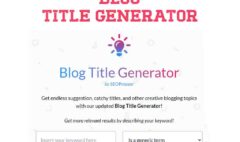H1 Headings SEO
H1 Headings SEO
H1 Headings SEO
H1 headings, also known as header tags, are an essential part of on-page SEO. They play a crucial role in helping search engines understand the structure of your content and the importance of each section. In this blog post, we’ll discuss what H1 headings are, why they are important for SEO, and how to optimize them for better search engine rankings.
What are H1 Headings?
H1 headings are HTML tags used to indicate the main heading or title of a webpage or section of content. They are typically displayed in a larger font size than other text on the page and can help users understand the main topic of the page.
Why are H1 Headings important for SEO?
H1 headings are important for SEO because they provide valuable information to search engines about the content of your page. Search engines use H1 headings to understand the topic and purpose of your page, and to determine the relevance of your content to specific search queries.
Optimizing H1 Headings for SEO
- Use only one H1 heading per page Each page of your website should have only one H1 heading. This heading should accurately reflect the main topic or purpose of the page.
- Include your primary keyword in your H1 heading Including your primary keyword in your H1 heading can help search engines understand the relevance of your content to specific search queries. However, it is important to use your keyword naturally and avoid stuffing it into your heading.
- Keep your H1 heading concise and descriptive Your H1 heading should be concise and accurately describe the main topic or purpose of your page. Avoid using vague or generic headings that do not provide clear information to search engines or users.
- Use CSS to style your H1 heading Use CSS to style your H1 heading to match the design of your website. This can include font size, color, and spacing. However, avoid using image-based headings, as these are not readable by search engines.
- Use secondary headings to structure your content Use secondary headings (H2, H3, etc.) to structure your content and provide additional information to search engines and users. These headings should accurately reflect the content of each section and provide a clear hierarchy of information.
Conclusion
In conclusion, H1 headings are an essential part of on-page SEO. By including a descriptive and concise H1 heading on each page of your website and using secondary headings to structure your content, you can improve your website’s search engine rankings and help users find the information they are looking for. Remember to use your primary keyword naturally and avoid stuffing it into your heading, and use CSS to style your headings for optimal readability and user experience.

